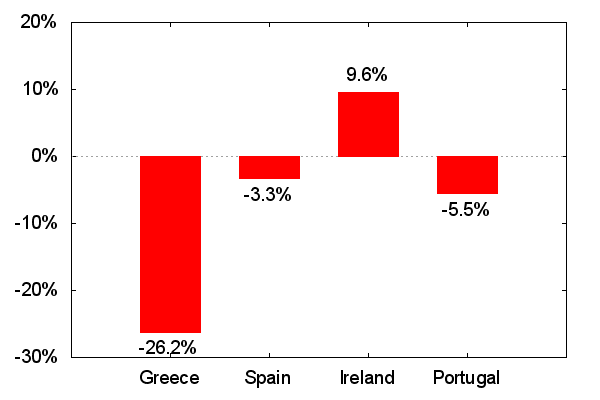

Explanations for the crisis in these eurozone countries have highlighted the imbalances that these countries accumulated, especially after the introduction of the euro. The most striking manifestations of the imbalances were the increasing levels of private and public indebtedness, and the current account deficits. All four countries have shown these signs, although not in a synchronized way.
The initial view on the apparent similarities between the bailed-out economies of the eurozone focused on whether the worst case till date would predict further problems in the rest of the Eurozone.
Nowadays, given the recovery seen in Ireland and, to some extent, in Portugal - note that both countries have concluded their bail-out programmes -, that Spain appears to have averted the worse and the fact that no other bail-outs have been required (with the exception of Cyprus, not included in our analysis), there is some hope that the eurozone may after all be heading for restoration (although the news concerning the European banking sector as very worrisome).
Nevertheless, the behavior of these economies is critical to the future of the euro. In this webpage we report data on the bailed-out economies. The report focuses on their macroeconomic performance, both internal and external, and on the evolution of the debt burden.
At the time of writing, the indicators presented below show that Greece stands out for displaying the worst performance among this group of countries. This casts doubts on its permanence in the euro area and, therefore, on the future of the euro.
On the other hand, Ireland, Portugal and Spain seem to share similar trends in most variables. Although those trends point in the right direction, the feeble growth and the high level of indebtedness, both public and private, raise concerns about the sustainability and the speed of the recovery. As long as indebtedness levels remain high, the recovery may be perceived as vulnerable to adverse shocks.
 Real GDP growth (year-on-year)
Real GDP growth (year-on-year) Growth rates have been strongly and persistently negative in Greece since mid-2008. GDP in 2015 is 26% lower than in 2007. In the other countries, there are signs of recovery since the beginning of 2013. However, the recovery has proceeded at very different speeds. Ireland was the first to take off: by 2014, its GDP was already above the pre-crisis level (the values presented do not take into account the latest, controversial, revision). Spain and Portugal had similar performances until 2014, but in 2015 Spain clearly outpaced Portugal. Given the recent growth rates, Spain's GDP will probably exceed its pre-crisis level in one or two years, while Portugal's GDP will probably need several years.
|
 Real GDP variation: 2015 relative to 2007
Real GDP variation: 2015 relative to 2007 
 Unemployment rate
Unemployment rate Unemployment appears to be on a declining trend since the beginning of 2013. However, unemployment in Greece and in Spain is slowly declining from a starting point above 25%, whereas in Ireland and in Portugal it declined faster from starting points between 15% and 18%.
|
 Employment rate
Employment rate Employment rates declined significantly after 2007-2008. Among the four countries, Greece was the most affected and Portugal the least. There are signs of recovery since early 2013.
|
 Interest rate
Interest rate By 2005 we were all Germans - Greeks, Spanish, Irish and Portuguese could all borrow at the same interest rate as Germans. The international financial crisis revealed 'who had been swimming naked' and the spreads started to climb. Greece has recorded the largest increase by far. Since mid-2012 the yields have been declining to below pre-crisis levels (at least in nominal terms). However, the interest rate on Greek bonds reverted the trend in the end of 2014. Uncertainty in the financial markets from the negotiations between the troika and the Greek Government in 2015 translated into a clear upward trend in Greek interest rates. There was also a slight upward trend in the interest rates of the other three countries in the beginning of 2015. The quarterly data show the Portuguese interest rate still on that upward trend.
|
 Daily interest rates in the last three months
Daily interest rates in the last three months |
|
|
 General government net lending (%GDP)
General government net lending (%GDP) The financial crisis induced large budget deficits in 2009, surpassing 10% of GDP. The deficits have persisted since then, although there is a positive trend. Comparison with primary deficits shows that interest payments have weighed heavily on public finances.
|
 General government primary balance (%GDP)
General government primary balance (%GDP)
|
 General government consolidated gross debt (%GDP)
General government consolidated gross debt (%GDP) Apart from Ireland, efforts to reduce public debt have not been successful so far.
|
 Private debt (%GDP)
Private debt (%GDP) Private debt is declining, although very slowly in Ireland and in Greece.
|
 Real effective exchange rate (42 trading partners, 2005=100)
Real effective exchange rate (42 trading partners, 2005=100) Since the beginning of the crisis, the real effective exchange rate of these countries has been declining (depreciating), although at different speeds. The decline has been larger in Ireland and smaller in Spain. Since 2015, the real effective exchange rate of all countries stabilised.
|
 Nominal unit labour cost index
Nominal unit labour cost index The nominal unit labour cost has been declining since the beginning of the crisis. Recently, the decline has been larger in Greece.
|
 Current account (%GDP)
Current account (%GDP) The current account has become positive in all countries. Ireland deserves a special mention: the current account balance, amid some controversy, is already 4%-6% of GDP.
|
 Net international investment position (%GDP)
Net international investment position (%GDP) This indicator shows the large external indebtedness of these countries. With the exception of Ireland, the signs of correction are still not very strong.
|